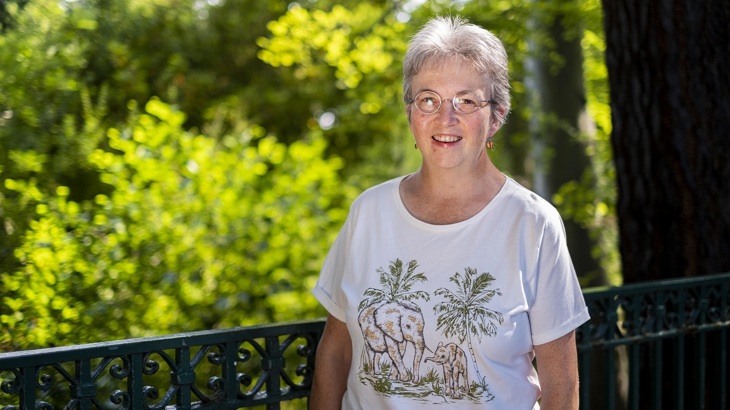The benefits of walking for our physical health are well known. But can taking a walk also positively impact our mental wellbeing? Senior Public Health Scientist Noelle O’Neill explains how walking can help people connect with nature – and each other.

Senior Public Health Scientist Noelle O'Neill.
Give It A Go is a new campaign being launched by Sustrans Scotland to help people aged 50-69 to walk or cycle more.
The campaign, supported by funding from the Scottish Government, aims to make it easier for the 1.4 million people aged 50-69 living in Scotland to leave the car at home and make walking and cycling part of their everyday routine.
Walking for contact
Noelle lives in Inverness with her partner, who is a wheelchair user.
Working in healthcare, she is no stranger to the health benefits of a brisk walk in the Highland capital.
But for Noelle, walking means so much more than that.
She explains:
“Walking brings so many positive elements into my life – it gives me the fresh air and freedom to appreciate, to breathe, to connect and to explore both the physical outside world and my own headspace.
“I am fortunate enough to have never felt lonely in my life but for me, walking gives me the space to inhale and exhale – to inhale and awaken my senses each morning and exhale at the end of a busy day.
“Walking is my mindfulness and my meditation.
“Walking enables me to make connections, whether that be with people, places, nature, green spaces and blue spaces.
“It helps me to connect to the great outdoors, great wildlife and great people!
“Walking has the ability to grow and nurture connections with communities in the widest sense.
“For some, walking may often be the only contact a person will have with others.”
This statement will ring true with many for whom walking was their only chance to exercise during the COVID-19 lockdowns.
Noelle recalls:
“During that time, I saw that walking offered the chance for people to change their view, their landscape, their perspective that many could only see from their room, flat or house window during the time of social distancing and restrictions.
“Walking opened up the window of opportunity for them to connect with others and in turn enabled them to connect with their community.
“A simple ‘hello’ that could make all the difference and help to alleviate someone’s feelings of isolation and loneliness.”
The challenge of moving through a city seen through a different lens
Getting around alongside her partner, a wheelchair user, has helped Noelle to see the challenges that towns and cities pose.
This perspective has allowed Noelle to consider the connection between such challenges and social isolation.
She says:
“If places are not accessible and cannot be easily reached due to unfriendly potholes, poorly designed and narrow pathways, and poor quality, uneven pavements being placed in their path, people with disabilities or those with mobility difficulties may, and indeed do, decide that the challenges that they would face by venturing into the outside world are just too daunting and difficult.
“In looking through my lens of living with someone who depends on a wheelchair, I see that for them, to stay indoors can sometimes bring feelings of despondency, sadness, suffocation and separation from society.
“But to go outdoors they can feel equally exposed, scared, unsure, unsafe and vulnerable.
“Whilst my partner’s resilient attitude and dogged determination of 'I won’t be defeated, I won’t give up' keeps them journeying through life on a daily basis, such challenges can regularly serve to heighten their feelings of social isolation and separation from their community, friends, family and social networks.
“So to break down such barriers, society must build better, more thoughtful, more practical pathways, roads and routes to enable all to actively travel across and within communities in an easy and enjoyable, safe and secure way.
“Otherwise, we collectively run the risk of denying people with disabilities in particular, and mobility issues in general, the opportunity to live active, connected, happy and fulfilling lives.”
When you think of life and living, think walking
Leaving the car at home to walk, wheel or cycle more of your everyday journeys can feel like a big decision to make.
It's a change that will be different for each of us, and dependent upon our unique circumstances.
When asked what her message would be to someone looking to create a more active routine, Noelle said:
“Start with small steps, small changes.
“Think about what brings or could bring you joy and happiness into your life and how walking could help you achieve that.
“Then ask, ‘what needs to happen to make that happen?' In other words, when you think of life and living, think walking.”
These views are solely of Noelle O’Neill and do not represent any thoughts or opinions of any other individuals or organisations.
Our new campaign aims to make it easier for people aged 50-69 living in Scotland to leave the car at home and make walking and cycling part of the everyday routine. Are you ready to Give it a Go?





